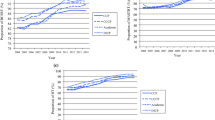Abstract
Purpose
This study was designed to determine whether accreditation by the National Accreditation Program for Breast Centers (NAPBC) is associated with improved performance on six breast quality measures pertaining to adjuvant treatment, needle/core biopsy, and breast conservation therapy rates at Commission on Cancer (CoC) centers.
Methods
National Cancer Database 2015 data were retrospectively reviewed to compare patients treated at CoC centers with and without NAPBC accreditation for compliance on six breast cancer quality measures. Mixed effects modeling determined performance on the quality measures adjusting for patient, tumor, and facility factors.
Results
Of 1308 CoC facilities, 484 (37%) were NAPBC-accredited and 111,547 patients (48%) were treated at NAPBC centers. More than 80% of patients treated at both NAPBC and non-NAPBC centers received care in compliance with breast quality measures. NAPBC centers achieved significantly higher performance on four of the five quality measures than non-NAPBC centers at the patient level and on five of six measures at the facility level. For two measures, needle/core biopsy before surgical treatment of breast cancer and breast conservation therapy rate of 50%, NAPBC centers were twice as likely as non-NAPBC centers to perform at the level expected by the CoC (respectively odds ratio [OR] 1.96, 95% confidence interval [CI] 1.85–2.08, p < 0.0001; and OR 2.05, 95% CI 1.94–2.15, p < 0.0001).
Conclusions
While NAPBC accreditation at CoC centers is associated with higher performance on breast quality measures, the majority of patients at all centers receive guideline-concordant care. Future studies will determine whether higher performance translates into improved oncologic and patient-reported outcomes.



Similar content being viewed by others
References
Winchester DP. The National Accreditation Program for Breast Centers: quality improvement through standard setting. Surg Oncol Clin N Am. 2011;20(3):581–6.
Link JS. History and overview of comprehensive interdisciplinary breast centers. Surg Oncol Clin N Am. 2000;9(2):147–57.
National Accreditation Program for Breast Centers. NAPBC standards manual. 2014 edn. Chicago, IL: American College of Surgeons; 2014.
Winchester DP. The United States’ national accreditation program for breast centers: a model for excellence in breast disease evaluation and management. Chin Clin Oncol. 2016;5(3):31–5.
Berger ER, Wang CE, Kaufman CS, et al. National Accreditation Program for Breast Centers demonstrates improved compliance with post-mastectomy radiation therapy quality measure. J Am Coll Surg. 2017;224(3):236–44.
American College of Surgeons. National Cancer Database. https://www.facs.org/quality-programs/cancer/ncdb/qualitymeasures. Accessed 10 Feb 2018.
Institute of Medicine. To err is human: building a safer health system. Washington, DC: National Academies Press; 1999.
Institute of Medicine. Crossing the quality chasm: a new health system for the 21st century. Washington, DC: National Academies Press; 2001.
Chee TT, Ryan AM, Wasfy JH, Borden WB. Current state of value-based purchasing programs. Circulation. 2016;133(22):2197–205.
Grossman MD, Yelon JA, Szydiak L. Effect of American College of Surgeons trauma center designation on outcomes: measurable benefit at the extremes of age and injury. J Am Coll Surg. 2017;225(2):194–9.
Azagury DE, Morton JM. Patient safety and quality improvement initiatives in contemporary metabolic and bariatric surgical practice. Surg Clin North Am. 2016;96(4):733–42.
American College of Surgeons. CoC quality of care measures. https://www.facs.org/quality-programs/cancer/ncdb/qualitymeasures. Accessed 5 June 2018.
National Cancer Database. Data Dictionary PUF 2015. http://ncdbpuf.facs.org/content/breast. Accessed 10 Feb 2018.
Leonard KL, Masatu MC. Changing health care provider performance through measurement. Soc Sci Med. 2017;181:54–65.
Kesson EM, Allardice GM, George WD, Burns HJ, Morrison DS. Effects of multidisciplinary team working on breast cancer survival: retrospective, comparative, interventional cohort study of 13,722 women. Br Med J. 2012;344:e2718.
Cheng SH, Wang CJ, Lin JL, et al. Adherence to quality indicators and survival in patients with breast cancer. Med Care. 2009;47(2):217–25.
Shulman LN, Palis BE, McCabe R, et al. Survival as a quality metric of cancer care: use of the National Cancer Data Base to assess hospital performance. J Oncol Pract. 2018;14(1):e59–72.
American College of Surgeons. Quality Programs. https://www.facs.org/quality-programs. Accessed 10 Feb 2018.
American College of Surgeons. Cancer Quality Improvement Program. https://www.facs.org/quality-programs/cancer/ncdb/qualitytools/cqip. Accessed 5 June 2018.
Author information
Authors and Affiliations
Corresponding author
Ethics declarations
Disclosures
The authors have no conflicts of interest to disclose.
Additional information
Publisher's Note
Springer Nature remains neutral with regard to jurisdictional claims in published maps and institutional affiliations.
This paper was presented in part at the Society of Surgical Oncology Annual Cancer Symposium on March 17, 2017 as an oral podium presentation.
Appendix: Selection Maps for Six Breast Quality Measures
Appendix: Selection Maps for Six Breast Quality Measures
Overall
-
1.
Select year of diagnosis 2015
-
2.
Select for female patients
-
3.
Select for age > 18 years old
-
4.
Select patients without previous cancers
-
5.
Select all of part of treatments performed at the reporting facility
BCS RT
Radiation therapy is administered within one year (365 days) of diagnosis for women under age 70 receiving BCS for breast cancer.
-
1.
Select for age < 70 years old
-
2.
Select for stageable histology
-
3.
Select invasive tumors
-
4.
Remove pathologic evidence of in situ or metastatic disease
-
5.
Select breast conserving surgery patients
-
6.
Remove patients with unknown radiation therapy status and timing
CHEMO HR-
Combination chemotherapy is considered or administered within four months (120 days) of diagnosis for women under age 70 with AJCC T1c, Stage II, or Stage III hormone-receptor-negative breast cancer.
-
1.
Select for age < 70 years old
-
2.
Select for stageable epithelial tumor
-
3.
Select invasive tumors
-
4.
Remove pathologic evidence of in situ or metastatic disease
-
5.
Select surgically treated
-
6.
Select for AJCC pathological stage T1cN0M0 or IB-III
-
7.
Select for hormone receptor negative
-
8.
Remove patients with unknown chemotherapy status and timing
TAM/AI HR+
Tamoxifen or third generation aromatase inhibitor is considered or administered within one year (365 days) of diagnosis for women with AJCC T1c, Stage II, or Stage III hormone-receptor-positive breast cancer.
-
1.
Select for stageable histology
-
2.
Select invasive tumors
-
3.
Remove pathologic evidence of in situ or metastatic disease
-
4.
Select surgically treated
-
5.
Select for AJCC pathological stage T1cN0M0 or IB-III
-
6.
Select for hormone receptor positive
-
7.
Remove patients with unknown hormone therapy status and timing
PMRT ≥4 NODES
Radiation therapy is considered or administered within one year (365 days) of diagnosis for women undergoing mastectomy for breast cancer with four or more positive lymph nodes.
-
1.
Select for stageable histology
-
2.
Select invasive tumors
-
3.
Remove pathologic evidence of metastatic disease
-
4.
Select mastectomy patients
-
5.
Remove unknown positive regional lymph nodes status
-
6.
Select for patients with 4 or more positive regional lymph nodes
-
7.
Remove patients with unknown radiation therapy status and timing
NEEDLE BX
Needle/core biopsy is performed prior to the surgical treatment of cancer.
-
1.
Select Phyllodes tumors
-
2.
Select in situ and invasive tumors
-
3.
Remove pathologic evidence of metastatic disease
-
4.
Select biopsy to the primary site
BCS 50%
A target rate of 50 percent of all eligible patients diagnosed with early stage breast cancer (Stage 0, I, II) are treated with breast cncserving surgery BCS.
-
1.
Select for stageable histology
-
2.
Select in situ and invasive tumors
-
3.
Select for AJCC clinical stage 0, I, or II
-
4.
Select surgically treated mastectomy and BCS cases
BCS = breast conserving surgery
Rights and permissions
About this article
Cite this article
Miller, M.E., Bleicher, R.J., Kaufman, C.S. et al. Impact of Breast Center Accreditation on Compliance with Breast Quality Performance Measures at Commission on Cancer-Accredited Centers. Ann Surg Oncol 26, 1202–1211 (2019). https://doi.org/10.1245/s10434-018-07108-7
Received:
Published:
Issue Date:
DOI: https://doi.org/10.1245/s10434-018-07108-7




